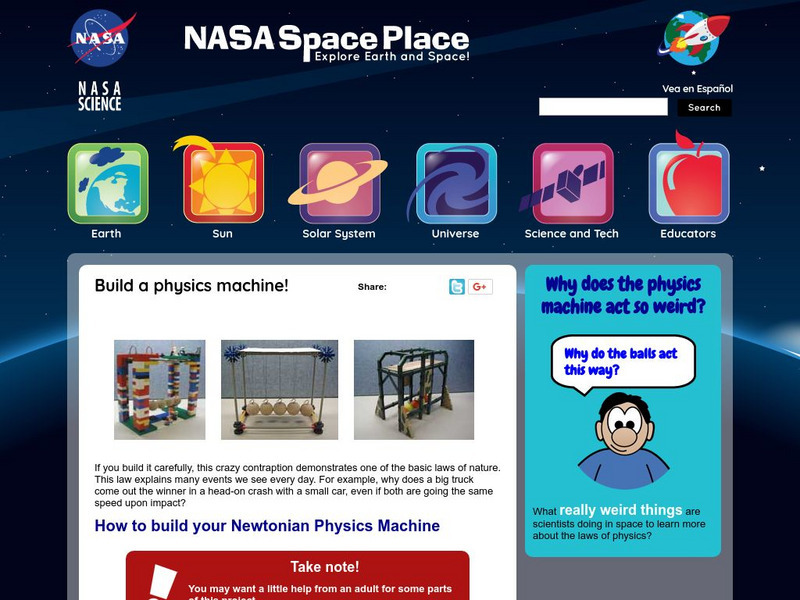OpenStax
Open Stax: Newton's Second Law of Motion: Concept of a System
In the following interactive students will begin to define net force, external force, and system and understand Newton's second law of motion. They will also apply Newton's second law to determine the weight of an object.
PBS
Pbs Learning Media: Newton's Triple Play: Baseball Science
In this lesson, students watch a video and animations that relate Isaac Newton's three laws of motion to baseball and apply what they've learned about these laws to another sport or other real-life situation.
Sophia Learning
Sophia: Newton's Second Law: Lesson 3
This lesson introduces Newton's Second Law and explains that force is equal to mass times acceleration. It is 3 of 3 in the series titled "Newton's Second Law."
CK-12 Foundation
Ck 12 Exploration Series: Simulations: Physics: Horse and Cart
[Free Registration/Login Required] Learn about Newton's third law of motion, calculations in two dimensions, and the interaction of multiple objects in the context of a horse pulling a cart.
OpenStax
Open Stax: Physics: Problem Solving Strategies
In the following interactive students will begin to understand and apply a problem-solving procedure to solve problems using Newton's laws of motion.
PBS
Pbs Learning Media: Acids and Bases: Making a Film Canister Rocket
ZOOM cast members mix different amounts of baking soda and vinegar to see which combination produces the most carbon dioxide for launching a film-canister rocket. [3:23]
CK-12 Foundation
Ck 12 Exploration Series: Simulations: Physics: Newton's Cannon
[Free Registration/Login Required] Learn about orbits and how an object can stay in orbit under the influence of gravity. By adjusting launch velocities users will understand how to successfully put a virtual satellite into orbit without...
University of Colorado
University of Colorado: Ph Et Interactive Simulations: Forces and Motion: Basics
Explore the forces at work when pulling against a cart, and pushing a refrigerator, crate, or person. Create an applied force and see how it makes objects move. Change friction and see how it affects the motion of objects.
Florida State University
Florida State University: Science, Optics & You: Sir Isaac Newton
Biography of Sir Isaac Newton (1642-1727), a scientist whose impact is felt in many disciplines today. His laws of motion are integral to basic physics, and he co-invented calculus.
Physics Aviary
Physics Aviary: Practice Problems: Motion on Incline Level 1
Students must calculate the distance an object will move up an incline using Newton's Laws. Mass, angle, gravitational field and initial speed will be generated randomly.
Physics Aviary
Physics Aviary: Practice Problems: Motion on Incline Level 2
Students must calculate the distance an object will move up an incline using Newton's Laws. Mass, angle, gravitational field, coefficient of friction and initial speed will be generated randomly.
Physics Aviary
Physics Aviary: Practice Problems: Motion on Incline Level 3
Students must calculate the speed of a block when it returns to its original location on an incline using Newton's Laws. Mass, angle, gravitational field, coefficient of friction and initial speed will be generated randomly.
Massachusetts Institute of Technology
Mit: Open Course Ware: Angular Momentum and Conservation
Students explore angular momentum and conservation. Some topics examined in the activities are angular momentum, torque, and conservation. The resource consists of video clips, lecture notes, practice problems, and exam questions....
ClassFlow
Class Flow: Newton's Laws
[Free Registration/Login Required] This flipchart explains Newton's Laws of Motion. Students are given definitions, practical examples and assessed on their knowledge.
Physics Classroom
The Physics Classroom: Satellite Motion
An animation depicting the path of projectiles launched at various launch speeds from the fictional Newton's Mountain. Accompanying text discusses satellite motion and the requirements of orbital motion. Links to further information is...
TeachEngineering
Teach Engineering: Motion Commotion
Students learn why and how motion occurs and what governs changes in motion, as described by Newton's three laws of motion. They gain hands-on experience with the concepts of forces, changes in motion, and action and reaction. In an...
The History Cat
The History Cat: Isaac Newton
Profile of Isaac Newton, with a description of his scientific theories, the impact he had on the world of science in his day, and the influence his ideas still have in the world today.
Other
Easy Science for Kids: All About Force: Pushing and Pulling
Students will understand that pushes and pulls can have different strengths and directions. Students investigate the effects of these different pushes and pulls.
NASA
Nasa: The Space Place: Build a Newtonian Physics Machine
Great hands on way to explain Newton's Second Law of Motion. Choose from three different Newtonian physics machines to build and test Newton's Second Law.
Physics Classroom
The Physics Classroom: Circular and Satellite Motion: Centripetal Force
Through illustrated examples and practice problems, students explore the centripetal force requirement. So for an object moving in a circle, there must be an inward force acting upon it in order to cause its inward acceleration.
Science Education Resource Center at Carleton College
Serc: Investigating Projectile Motion: Creating a Catapult
This instructional activity is for 9th grade physical science students. It begins with an inquiry-based instructional activity using a projectile motion computer simulation. It culminates with students building a catapult; applying and...
Pennsylvania State University
Acoustics and Vibration Animations: Demonstrations: The Simple Pendulum
A series of graphics, downloadable animations and text describe and explain the motion of a pendulum. Some sections require an understanding of calculus.
University of Maryland
Thinking Problems in Oscillations and Waves: Pendulum
A series of thought-intensive, multichoice questions concerning pendulums and provided for by the University of Maryland. A downloadable software program on pendulums is also included.
Science Education Resource Center at Carleton College
Serc: Investigating Newton's 3rd Law: Coin Flick
In this elementary physics investigation, students explore Newton's 3rd Law of Motion: To every action there is an equal & opposite reaction. Pairs of students will line up 5 pennies, (touching each other), between 2 rulers. The row...











